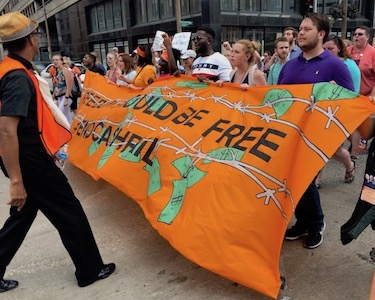General Assembly 2018, A Drama in 3 Acts
Act I. The Prophetic March to End Cash Bail

It was a glorious moment: hundreds of General Assembly commissioners marched down to the St Louis jail to support bailing out persons unable to post bail, and to oppose the cash bail mechanism that keeps many unconvicted people in jail around the country. The march was enthusiastic, and the amount of money raised specifically for the purpose was also quite impressive: $47 thousand. The church seemed to be a movement for justice, demonstrating on behalf of a just cause.
The march was led by prophetic local leaders who have been demonstrating on the street periodically since the death of Michael Brown and the exoneration of police officers in similar cases. The local organizers insisted—as a matter of principle—that a march permit not be obtained from officials whose actions they have challenged, though the Office of the General Assembly did coordinate with the police. So the church joined in solidarity with supporters of the Black Lives Matter movement and with others who are resisting a criminal justice system that is deeply marred by systemic racism.
___________________________________________
So the church joined in solidarity with supporters of the Black Lives Matter movement and with others who are resisting a criminal justice system that is deeply marred by systemic racism.
___________________________________________
The Assembly also gave implicit support to the Poor Peoples Campaign, which continues Martin Luther King’s last campaign. Co-Chair of that campaign, Presbyterian minister Liz Theoharis, spoke on raising the banner of that “moral revival.”
The early momentum of an Assembly may also favor the fresh energy of the proponents of many causes. But was that movement side of the church going to prevail?
Act II. The Way Forward Commission’s New Institutional Structure
Two days later the commissioners voted to add a new corporate structure, very similar to a board of trustees, to control the assets of the Presbyterian Mission Agency.
The action came with very strong institutional support from agencies other than the Mission Agency itself. It was portrayed as a way to help that body do its work without worrying too much about managing finances. The new trustee-like board is mandated to have people of color on it, but is not covered by the normal review process for GA agencies.
The Way Forward and All Agency Review action replaced the Mission Agency board members with representatives of other agencies (which retain their own boards) on a new 11 person “A-Corp” board partly to oversee the provision of “shared services” for a building that mainly houses the Mission Agency. Yet this re-constituted board will also control the endowments dedicated to mission by generations of Presbyterians. Further, its unnamed future president and staff are exempted from the 5:1 maximum ratio of highest-to-lowest salaries that governs the staff of the mission agency. So a largely unaccountable administrative layer was added to a body criticized for being too corporate, and the majority of its voting members will not be significantly affected by the decisions it makes.
___________________________________________
The larger issue is the susceptibility of board-type structures to institutional thinking.
___________________________________________
In the view of the Advisory Committee on Social Witness Policy, this was an unnecessarily structural response to a leadership and culture problem in the Mission Agency, a response that may in fact reinforce the primacy of corporate-style power over mission in the now seven national agencies. (Separately, the Mission Agency Board itself has reinforced that tendency by naming its executive director a “president,” linking that person more to structure than to the work of mission.)
The larger issue is the susceptibility of board-type structures to the institutional thinking that seduced the Way Forward; the alternative is to reinforce the council-side of the church: the open spaces for democratic deliberation where diverse voices can be heard and moral discernment exercised. Certainly legal incorporation is necessary in our society for all bodies holding material assets, but our tradition normally subordinates those financial and property concerns to full-on debate by representative bodies on the council model. The comment by Theology and Worship, added to the ACSWP advice on the Way Forward, provides some of the theological reasoning for this.
Clearly the details of the additional body can be debated more than they were on the Assembly floor, but the commissioners unquestionably added to the institutional structure of the denomination at costs that will come out of endowments given for mission.
Act III. The Fight over Immediate Divestment of Fossil Fuel Stocks and Bonds

Fossil Free orange shirts fringed the Assembly hall, following a pilgrimage by some of their number from Louisville to St. Louis. Their message was simple: Direct the investment agencies to get out of all fossil fuel securities. Those companies, they believe cannot be fundamentally affected by shareholder action. Is it even good to shift the major energy companies so they control more of the renewables market share? The movement among colleges and universities to divest of fossil fuels seems to have slowed, but divestment remains a powerful symbol.
The debate over divestment is often framed as integrity versus effectiveness, with solidarity weighing in depending on the issue. Mission Responsibility Through Investment stresses that integrity is not purity; those who favor divestment tend to value integrity however defined. Meanwhile, the investment bodies are constrained by the financial side of fiduciary stewardship, though one can define fiduciary more broadly. MRTI is, crucially, a rare place where the “rich board” lions (of Pensions and Foundation) lie down with the lambs of the advocacy committees and the Mission Agency. In the past, the two finance boards were more resistant to shareholder resolutions and to considering focused divestment (as with the Israeli- settlement connected companies), so it important to have a table where these different church groups can sit together.
The Fossil Free movement dismisses the institutional considerations of MRTI, and in fact focuses on divestment as part of a different overall script as to how social change is made. So what if the Texas presbyteries feel rejected? So what if our credibility as an activist investor is weakened? The overall activist work is to keep the carbon in the ground.
___________________________________________
The vote on the energy company divestment appears to confirm the institutional tilt of this year’s Assembly.
___________________________________________
Could the passion of the movement be maintained without a simple and clear “ask?” In terms of the work of the Assembly, there are other actions where the more activist and less institutional approach was taken, as in the call for near-unilateral nuclear disarmament. But in the area of energy, the practical applications are more obvious and the integrity argument can go two ways, as some personal dependence on fossil fuels in long distance travel is almost unavoidable.
Did the Fossil Free divestment overture need to try to “direct” the investment boards, however unlikely they would respond outside the MRTI process? Was any compromise possible, like immediately selling off all bonds that do not offer a voice of ownership (as ACSWP proposed)? Movements typically draw on younger folks, true for Fossil Free, and the “dying in” that protested the 2:1 vote not to divest showed a new generation of strategies.
The vote on the energy company divestment appears to confirm the institutional tilt of this year’s Assembly. Fossil Free definitely affected the language and thinking of the Assembly, but one suspects that the Board of Pensions voice was stronger in the hall—and the language of “direct” may have brought their voice in more strongly. In 2016, the vote to go with MRTI was even stronger, and the tilt in airtime toward them much stronger. This year Fossil Free got a bit more airtime, but the penalty of the minority-protecting tilt of Roberts Rules worked for MRTI.
Near the end of this Assembly, the choice before the church of movement or institution seems pretty stark. With new leadership in both the Clerk’s office and now the Presbyterian Mission Agency, however, the direction toward a “justice church” seems equally clear.
One lesson of the Fossil Free effort may be not to bank on immediate transformation, even if that transformation (toward a green church) is very needed. But the larger lesson of the End Cash Bail march and of Fossil Free is that leadership and creativity with symbols count. The blessing of the Assembly is that we still have a council where this moral energy can speak to the whole church.
As commissioners go home, this staff member covets the prayers of the church, so that the national staff affected by structural changes will nonetheless continue their energy for mission, and to respect also the voices of those whose views were not adopted.
***
Author Bio: Chris Iosso is Senior Editor of Unbound and a minister in the PCUSA. He has served as a pastor and as an ethicist staffing the Advisory Committee on Social Witness Policy. He joyfully begins each day at General Assembly with a run, and stays until the bitter end of plenary.






Unbound Social